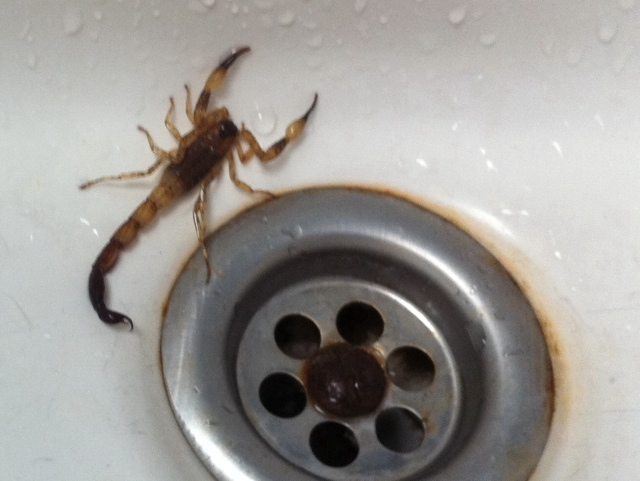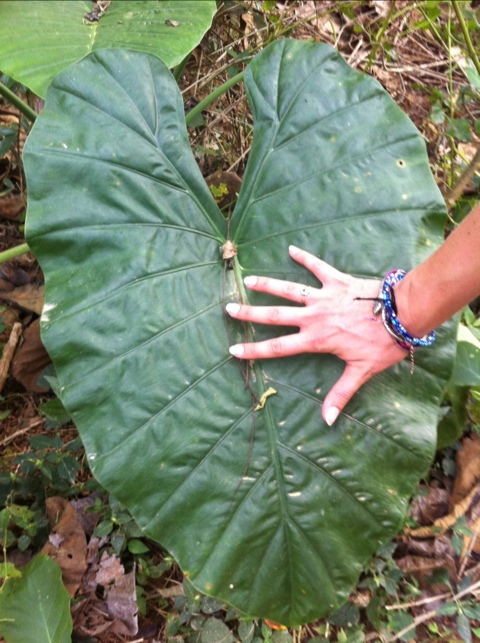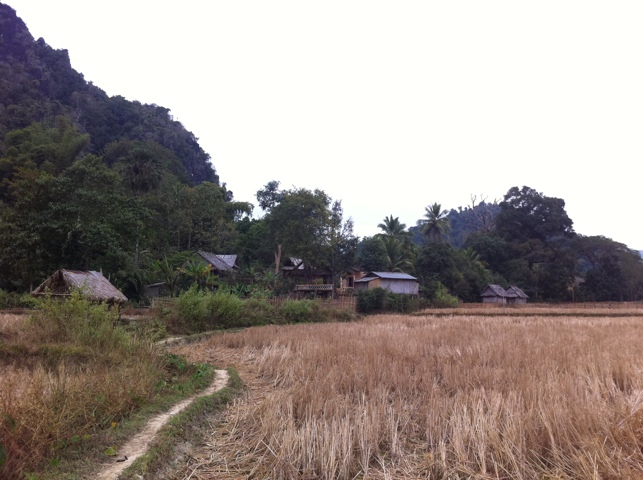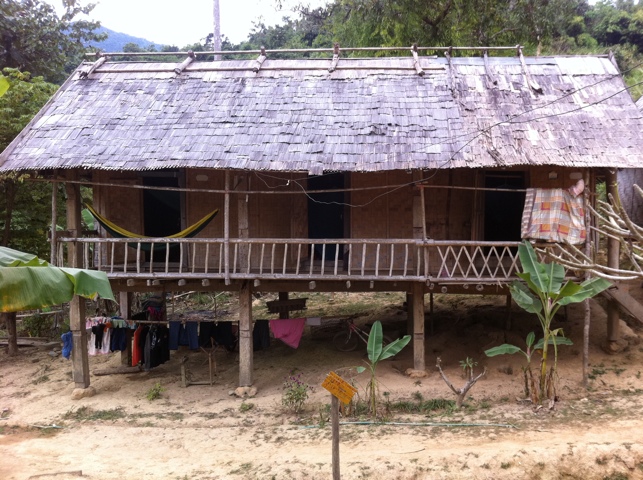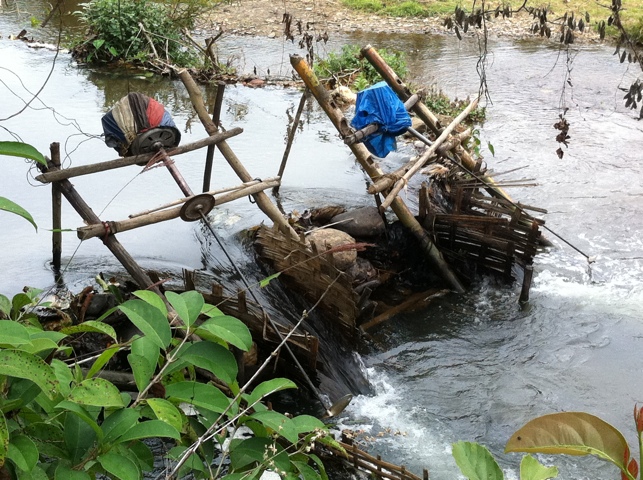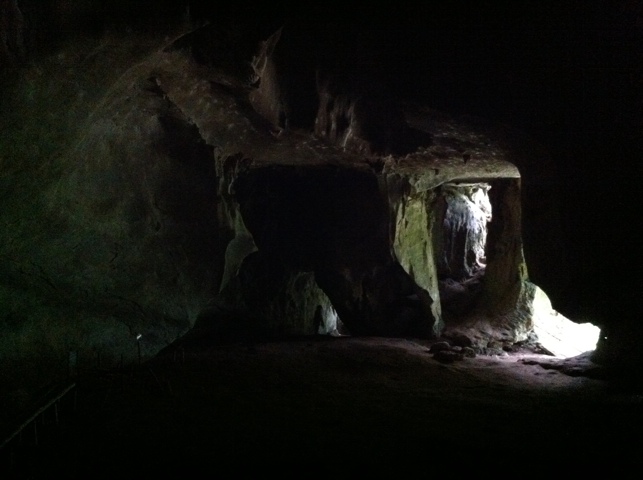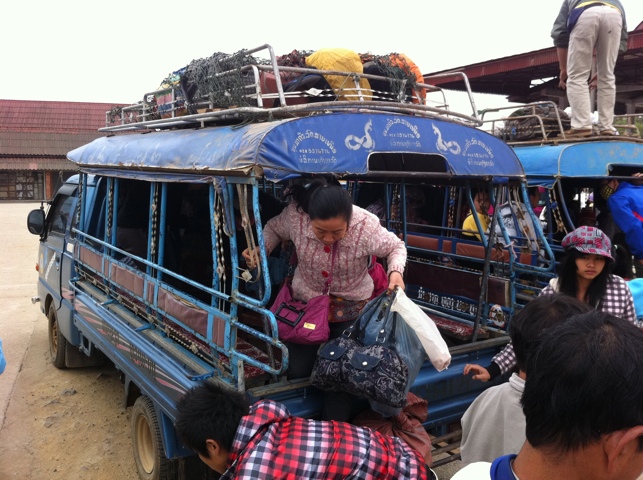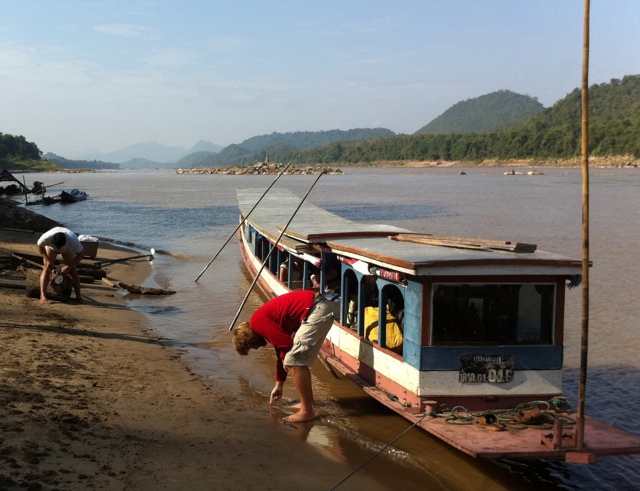
Our boat for the journey up to Nong Khiaw. You can see the captain/mechanic trying to fix the propellor on the left.
Eager to discover how Laos could possibly get any more sleepy than we’d found in Luang Prabang and Vientiane, we decided to take a break from it all and head upriver to the remote town of Muang Ngoi Neua.
We’d been promised a memorable six hour journey to the intermediate town of Nong Khiaw, and it was certainly epic – in all senses of the word. The boat was shaped like a javelin, a craft about two metres wide and 15 long, with two rows of child-size wooden seats down each side and a dozen of us on board. And just like its javelin equivalent, it had no cushions. Six hours is a long time to be sitting on a tiny wooden stool with your knees pressed against your chest. It’s particularly long when it turns out the journey actually takes ten hours, travelling all morning, all afternoon, and arriving in the dark!
Even if somewhat of a test of our endurance, the journey was stunning. As we headed upstream along the Mekong and then the Nam Ou rivers, we passed villagers with fishermen out on their narrow canoe-like boats, and towering karst limestone cliffs, which dominate the landscape. I’ve never really travelled a long way on a river before, but it’s interesting to see how much the surface changes as you travel along, from calm quiet waters one second to choppy rapids the next, presumably as the depth decreases, causing the water to run much faster. Although it’s dry season, we were surprised at the speed of the river, with the upstream journey at times an alarming struggle for our small boat. On a couple of occasions the river had narrowed and with the engine going at full throttle we were only just able to keep going forward, us shouting words of encouragement as the pilot tried to find the right line between the slower running water at the edge and not running us aground or into the overhanging greenery.
We’d initially been hoping to make our onward journey the same day, but it became apparent that was not to be, as we soon had to stop for repairs to a broken propellor. After an hour of our captain turning mechanic and running around in just his underpants to everyone’s amusement, we set off again, with the delay meaning we were still going as the sun set and it got dark. Given the boat lacked lights, this was a bit more of a challenge, but we finally made it with the moon to guide us, in spite of the well-meaning attempts of an American woman who got her torch out and proceeded to accidentally shine it in the captain’s eyes, eliminating any night sight he’d picked up. We later found out that some delay befalls the boat every day – everyone we’d spoken to had a journey of at least 10 hours, so they’re quite used to it, although we’re not entirely sure why they don’t have a spare light just in case!
After a stopover in Nong Khiaw, we took a quick (well, 90 mins was quick compared to the previous day!) boat journey to the village of Muang Ngoi Neua. It’s brilliantly remote, with no mains electricity or roads, so you have to get there on water. Although not free of tourists – the one street is lined with guest houses – it was a great place to chill out and practice our hammock skills in idyllic rural surroundings. Most of the places are pretty rustic – small stilt bungalows with weaved bamboo walls and floorboards on the floor. On our first night, we found the place we were staying a little too rustic for our liking; we woke to find a small scorpion in the sink. We thought the thing was dead, an assumption that Laura to her horror discovered to be false while in the bathroom – with the door locked from the outside! Yes, I was the the one that locked that door (although with Laura’s agreement), and yes I did feel pretty bad about it! As we were scrabbling to set Dr Butler free from her scorpion prison, i suddenly remembered a less-than-helpful ‘fact’ I’d picked up from a recent Indiana Jones film – it’s the little scorpions that are the most deadly! Fortunately, it didn’t get her. Panic over, we quickly relocated to somewhere nicer on the riverfront, and we were a little more careful about wandering around barefoot after that!
One day we went trekking to see some nearby villages. The trip took us through forests of green bamboo and lines of mysterious tall trees. You could for a moment believe this was a land of giants, with the greenery soaring to the sky above, and humongous leaves carpeting the floor below. Perhaps this is where those huge Buddha footprints came from? We plodded on through valleys of dry rice paddies, their wispy yellow stalks wavering in the wind like wheat, creating a beautiful picture against the sky and green mountains.
The village we stopped in for lunch comprised entirely of bamboo stilt houses – in a design we’ve seen elsewhere in Laos, each wooden stilt of the house rests on a large boulder for foundations, making it look like the whole place could be shifted horizontally with a shove. We didn’t try!
Since there’s no electricity supply, people who need it rely either on diesel generators for a few hours a day (which is how they light the town we were staying in), or they use little dynamos suspended in the river nearby. We wandered across the paddies to take a look, following the telltale sign of the rustic-style electricity pylons, not great grey monstrosities, but instead sticks of bamboo with a bit of black bell wire running between them. Simple but effective!
On the way back downstream, we stopped in Nong Khiaw to visit the local Than Pha Thok caves, home to the Luang Prabang provincial government during the war. Set high up and deep within the cliffs, the caves run for hundreds of metres, with areas for different sections of the administration. Next to the council chamber, there was a space labelled ‘Art Dept’; we had romantic visions of experts in oil and watercolour painting the scenes at war for posterity, until we realised that ‘art’ probably stood for ‘artillery’! Round the cliff, the two 10 year old guides we’d adopted took us to a second much more narrow opening, essentially a long tunnel running far into the rock, with chambers coming off it. With only our torches to light the way, we crawled through, not wanting to look too closely for the eight-legged inhabitants that were probably also enjoying the cool and dry inside. The space was used by the regional bank during the conflict, and it wasn’t hard to see why – the single narrow twisting passageway would have made it easy to defend, and there was plenty of space inside. It was claustrophobic enough though, and I can imagine it must have been pretty hellish during the war with bombers striking the hillside outside making everything shake. At one point, crouched on a rocky ledge, we switched off both our torches to see how dark it was, and our 10 year old assistants soon told us the answer through their squeals – scarily dark!
For the return journey to Luang Prabang we took the bus, a cramped three hour trip on a Sawngthaew. At one point, I counted 20 of us on the back, with 5 sacks of vegetables! With the wind rushing past us sitting on the open back of a pick-up and the lack of sun, we both actually felt cold for the first time in months. It reminded us that it is actually winter (I guess those back home might have noticed before now!), and time for us to head south to warmer climes for Christmas.
Simon

